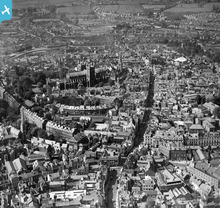EPW041170 ENGLAND (1933). Exeter Cathedral and the city centre, Exeter, from the north-east, 1933
© Copyright OpenStreetMap contributors and licensed by the OpenStreetMap Foundation. 2025. Cartography is licensed as CC BY-SA.
Nearby Images (17)
Details
| Title | [EPW041170] Exeter Cathedral and the city centre, Exeter, from the north-east, 1933 |
| Reference | EPW041170 |
| Date | May-1933 |
| Link | |
| Place name | EXETER |
| Parish | |
| District | |
| Country | ENGLAND |
| Easting / Northing | 292330, 92874 |
| Longitude / Latitude | -3.52560514406, 50.724926735268 |
| National Grid Reference | SX923929 |
Pins

Alfonso Keller |
Thursday 7th of December 2023 02:34:54 PM | |

Alfonso Keller |
Wednesday 6th of December 2023 04:36:46 PM | |

Kate Burhouse |
Saturday 27th of February 2021 02:35:03 PM | |

Kate Burhouse |
Saturday 27th of February 2021 02:28:26 PM | |

Kate Burhouse |
Saturday 27th of February 2021 02:26:24 PM | |

Class31 |
Thursday 20th of June 2013 10:40:46 AM | |

Class31 |
Thursday 20th of June 2013 10:38:38 AM | |

Class31 |
Thursday 20th of June 2013 10:34:29 AM | |

Class31 |
Thursday 20th of June 2013 09:31:51 AM | |
Allen T |
Wednesday 15th of May 2013 08:27:46 PM | |
Allen T |
Wednesday 15th of May 2013 08:23:47 PM | |
Allen T |
Wednesday 15th of May 2013 08:23:12 PM | |
Allen T |
Wednesday 15th of May 2013 08:21:56 PM | |
Allen T |
Wednesday 15th of May 2013 08:20:55 PM | |
Allen T |
Wednesday 15th of May 2013 08:19:35 PM | |
Allen T |
Tuesday 14th of May 2013 12:10:41 PM | |
Fred Karno. Born Frederick John Westcott in Paul Street, Exeter on 26th March 1866. Fred was originally a slapstick comedian credited with the invention of the "custard pie in the face" gag and the man who gave Charlie Chaplin and Stanley Jefferson (Stan Laurel) their first chance in show business. Although the family had moved to Nottingham by the time Fred was nine years old, he always said "Devon born and proud of it". He was indentured to a plumber for 7 years. Fred joined an Exeter gymnasium after doing some repairs there - a natural athlete he was soon winning prizes at local fêtes. He joined with a juggler to become Alvene and Leonaro in a circus. This led to pantomime and another collaboration with gymnasts Bob Sewell and Ted Tysall as the Three Karnos. He started calling himself Fred Karno, although he didn't change his name by deed poll until 1914. By the 1890's Karno started to concentrate on promoting slapstick comedy acts using a range of different performers. He first appeared on stage with a young Charlie Chaplin in 1901, after Syd Chaplin, who was an employee, had persuaded Fred to take his young brother on. By 1906 he was promoting 32 different sketches around the country. Fred became so successful that he turned his house in Vaughan Road, London into the Fun Factory, a headquarters for nurturing new talent, storing props and managing acts. He can be credited with discovering Max Miller, and Flanagan and Allen although his most famous discoveries are Charlie Chaplin and Stan Laurel. It was in 1908, Fred Karno leased his first theatre, the old Royal Public Rooms in London Inn Square, Exeter, renaming it the Hippodrome. |
Allen T |
Wednesday 22nd of May 2013 11:43:27 AM |
Allen T |
Monday 13th of May 2013 11:34:02 PM | |
Allen T |
Monday 13th of May 2013 11:32:44 PM | |
Allen T |
Monday 13th of May 2013 11:32:11 PM | |
Allen T |
Monday 13th of May 2013 03:39:32 PM | |
Allen T |
Monday 13th of May 2013 03:39:08 PM | |
Allen T |
Monday 13th of May 2013 03:37:24 PM | |
Allen T |
Monday 13th of May 2013 03:23:33 PM | |
Allen T |
Monday 13th of May 2013 03:22:03 PM | |
Allen T |
Monday 13th of May 2013 03:20:24 PM | |
Allen T |
Monday 13th of May 2013 03:19:13 PM | |
Of the three purpose built cinemas in Exeter that were constructed in the 1930's, the Gaumont was the earliest when it was opened on Whit Monday, 16th May 1932 by Arthur C Reed MP for Exeter. Built on a site off North Street, it had a grand entrance gate on the street itself that opened into the courtyard in front of the cinema. The site was cramped and had previously been occupied by the Yacht Beverage Co Ltd, a producer of fizzy drinks. The cinema, designed by William H Watkins, could accommodate an audience of 1,499 in what was known as a stadium-type layout in which the stalls and circle were on the same, raked floor. The walls of the auditorium were covered with painted panels showing Medieaval life with a ceiling dominated by a central dome of ribbed plaster and a central light. In common with most other cinemas of the 1930's, it had a grand secondhand, 2 manual, 9 rank Wurlitzer organ installed to entertain the audience between shows and in the intervals, and the 'Ardenie Earphones' system fitted to the seats for the use of the deaf. It was originally called the Gaumont Palace under its owners, the Gaumont British Picture Corporation, who were partners with Albany Ward in the Palladium Cinema, Paris Street. The Gaumont was their answer to the opening, in 1931, of the Plaza in London Inn Square. When, in the 1950's Gaumont merged with the owners of the Odeon, the Rank Organisation, it became known as the Gaumont Theatre. Unlike the Plaza, the Gaumont was purpose built, with its architect, William Henry Watkins FRIBA of Bristol, and designer Percy Bartlett, creating an unusual Scandinavian, Art Deco hybrid. The Gaumont-British Picture Corporation appointed Mr Ralph M Leddra, previously manager of the Palladium, Paris Street, as manager. With acknowledgement and thanks to Exeter Memories. |
Allen T |
Tuesday 14th of May 2013 11:49:03 AM |
Allen T |
Monday 13th of May 2013 03:17:33 PM | |
Two Theatre Royals were positioned at the meeting point of Longbrook Street and New North Road, and it was the tragic fire that destroyed the first, in September 1887 with the loss of 186 lives that saw some of the most distressing scenes in London Inn Square. A poem written by William Topaz McGonagal, at the time, has the verse: The shrieks of those trying to escape were fearful to hear, Especially the cries of those who had lost their friends most dear; Oh, the scene was most painful in the London Inn Square, To see them wringing their hands and tearing their hair! With thanks to Exeter Memories |
Allen T |
Monday 13th of May 2013 03:38:28 PM |
Allen T |
Monday 13th of May 2013 03:16:20 PM | |
St Lawrence was one of the churches lost on the 4th May 1942, when the city suffered its worst bombing raid of the Second World War. The church was burnt out, but film taken after the raid indicates the fabric, including the tower, survived. Dating from before the thirteenth-century, it was mentioned in a deed of 1202 when it belonged to the abbot and convent of St Mary de Valle in Bayeux, Normandy. In 1275, Henry III gave permission for it to be passed to the Augustinian priory and convent of Merton, Surrey, who in turn gave it to St John's Hospital at the request of Bishop Peter Quivil. During the Commonwealth, St Lawrence was one of the thirteen parish churches selected for disposal by the Parliamentary Commissioners. It was purchased back by a wealthy parishioner on 21 September 1658, for £100, and returned to the parish, saving it from destruction. The Church Building Situated on the northern side of the High Street, the church had an enclosed porch with a Norman arched entrance, constructed in 1674, from the materials of an ornamental water conduit that stood close by, in the middle of the High Street. Over the porch, in a Gothic niche, was a statue of Queen Elizabeth I, which was originally sited on the conduit. The conduit displayed the city coat of arms with the date 1590. In 1804, the statue was the subject of a vandal when on 6 May, the head of Good Queen Bess was removed and placed on a spike in front of the church. Mr John Cooke was commended for offering a reward of five guineas for apprehending the offender. With acknowledgement and thanks to Exeter Memories. |
Allen T |
Tuesday 14th of May 2013 11:55:16 AM |
Allen T |
Monday 13th of May 2013 03:15:28 PM |
User Comment Contributions
Allen T |
Tuesday 14th of May 2013 01:06:39 PM |


![[EPW041170] Exeter Cathedral and the city centre, Exeter, from the north-east, 1933](http://britainfromabove.org.uk/sites/all/libraries/aerofilms-images/public/100x100/EPW/041/EPW041170.jpg)
![[EPW024132] London Inn Square and environs, Exeter, 1928](http://britainfromabove.org.uk/sites/all/libraries/aerofilms-images/public/100x100/EPW/024/EPW024132.jpg)
![[EAW051160] Exeter Castle and the surrounding area, Exeter, 1953](http://britainfromabove.org.uk/sites/all/libraries/aerofilms-images/public/100x100/EAW/051/EAW051160.jpg)
![[EPW024109] London Inn Square and environs, Exeter, 1928](http://britainfromabove.org.uk/sites/all/libraries/aerofilms-images/public/100x100/EPW/024/EPW024109.jpg)
![[EAW051172] The High Street and city centre, Exeter, 1953](http://britainfromabove.org.uk/sites/all/libraries/aerofilms-images/public/100x100/EAW/051/EAW051172.jpg)
![[EAW051171] The site of Bedford Circus, Heavitree Road and environs, Exeter, 1953](http://britainfromabove.org.uk/sites/all/libraries/aerofilms-images/public/100x100/EAW/051/EAW051171.jpg)
![[EPW024103] Bedford Circus and environs, Exeter, from the east, 1928](http://britainfromabove.org.uk/sites/all/libraries/aerofilms-images/public/100x100/EPW/024/EPW024103.jpg)
![[EAW051161] Exeter Castle, St Peter's Cathedral and the surrounding area, Exeter, 1953](http://britainfromabove.org.uk/sites/all/libraries/aerofilms-images/public/100x100/EAW/051/EAW051161.jpg)
![[EAW051170] The site of Bedford Circus and the city centre, Exeter, 1953](http://britainfromabove.org.uk/sites/all/libraries/aerofilms-images/public/100x100/EAW/051/EAW051170.jpg)
![[EPW024104] Bedford Circus, Exeter, 1928](http://britainfromabove.org.uk/sites/all/libraries/aerofilms-images/public/100x100/EPW/024/EPW024104.jpg)
![[EAW003658] St Peter's Cathedral, Bedford Circus and the city centre, Exeter, 1930s](http://britainfromabove.org.uk/sites/all/libraries/aerofilms-images/public/100x100/EAW/003/EAW003658.jpg)
![[EPW003658] St Peter's Cathedral, Bedford Circus and the city centre, Exeter, 1930s](http://britainfromabove.org.uk/sites/all/libraries/aerofilms-images/public/100x100/EPW/003/EPW003658.jpg)
![[EAW051165] The city centre, Exeter, 1953](http://britainfromabove.org.uk/sites/all/libraries/aerofilms-images/public/100x100/EAW/051/EAW051165.jpg)
![[EAW051163] The city centre, Exeter, 1953](http://britainfromabove.org.uk/sites/all/libraries/aerofilms-images/public/100x100/EAW/051/EAW051163.jpg)
![[EAW005853] The city centre, Exeter, 1947](http://britainfromabove.org.uk/sites/all/libraries/aerofilms-images/public/100x100/EAW/005/EAW005853.jpg)
![[EAW003659] The city centre, Exeter, 1930s](http://britainfromabove.org.uk/sites/all/libraries/aerofilms-images/public/100x100/EAW/003/EAW003659.jpg)
![[EPW003659] The city centre, Exeter, 1930s](http://britainfromabove.org.uk/sites/all/libraries/aerofilms-images/public/100x100/EPW/003/EPW003659.jpg)




